Affiliate disclosure: This post may contain affiliate links. Please see our Privacy Policy.
When you make your own strawberry jam at home, it’s up to you to decide how much (or how little) sugar to add. Low sugar strawberry jam adds just enough sugar to bring out the full flavor of the berries, but not so much that you can’t taste their natural sweetness.
The very first time I made jam, I followed an old school recipe that used one cup of sugar for every cup of fruit. I was just 12 and making peach jam with an experienced canner.
They looked at me and said, “Are you sure? You know you can choose to use a different amount right? That’s the nice thing about canning your own.”
What can I say, I was a kid. More sugar is better, right? If I can choose, why not double the sugar?!?!?
The end result of that batch was pretty disappointing. So much sugar that I couldn’t taste any hint of fruit, and even as a kid I thought it was a bit of a waste.
The fruit was so good before it went into the jar, and with all that fruit I couldn’t even taste it. Since then, I’ve always reduced the sugar in my jam recipes.
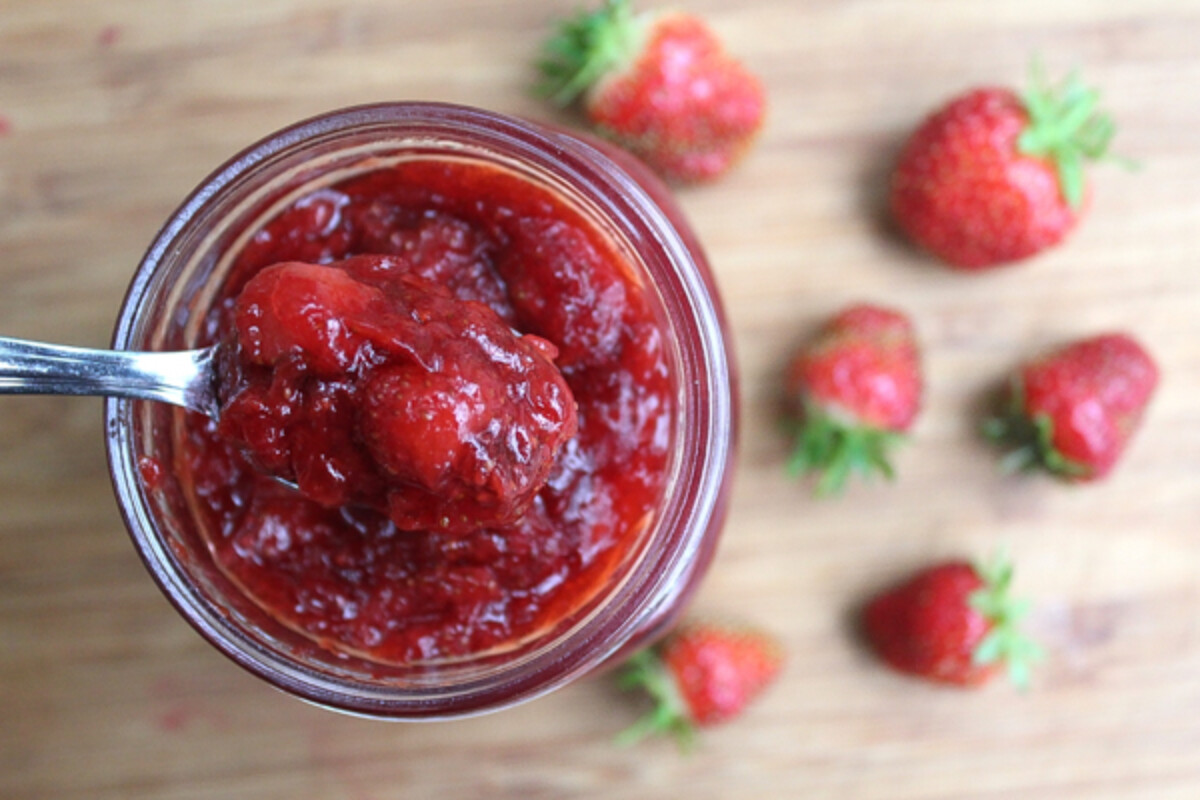
The key to good low sugar strawberry jam is choosing the right fruit. Unlike high sugar jam, in this version, you’ll be able to taste every nuance in the berries, and if they’re lacking you’ll know it.
Clamshell packages of storebought berries are not the best choice because they use varieties that are known to ship and keep well. Taste is only a secondary concern.
Start by taking a trip down to your local strawberry pick your own, or better yet, plant your own strawberries. Local berries are obviously fresher, but they’re also generally better-tasting varieties. They don’t need to make it more than a day or two from the field to table, so taste can be the first priority.
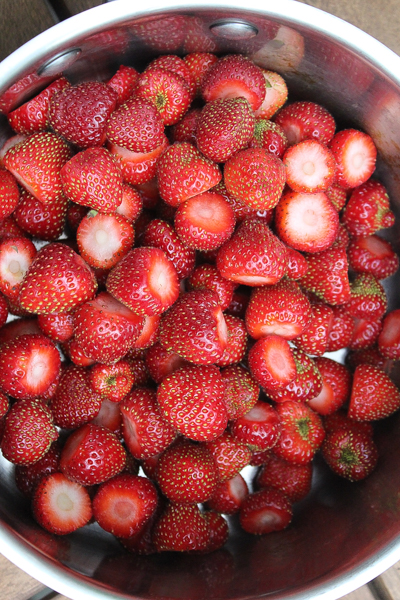
Once you have berries in hand, give them a quick wash. Use your fingertips or a sharp knife to remove the green tops. This is known as “hulling” the berries.
I’ve seen fancy tools for this, and it always surprises me how many people buy them. This strawberry huller has nearly 3,000 reviews, which means at least that many people bought it, likely many thousands more. For about the same price, you can buy a good, sharp professional-grade paring knife that works a lot better and is useful year-round.
The next step is deciding on a texture for your jam. I like my strawberry jam chunky, with big pieces of fruit still left in it.
Some recipes will tell you to start by pureeing the strawberries in a food processor or blender, and that’s perfectly fine if that’s your jam. For me, I like the big pieces of berry, and I feel like a kid in a candy store when I pull one of those hunks out and plop it onto my toast.
Either way, the berries do need a little mashing so that they’ll release their juice. Adding water to the pot dilutes the jam and is completely unnecessary.
A few quick mashes with a potato masher are enough to break them up a bit and provide plenty of cooking liquid. If you like a smoother jam, keep mashing a bit longer and you can skip the food processor.
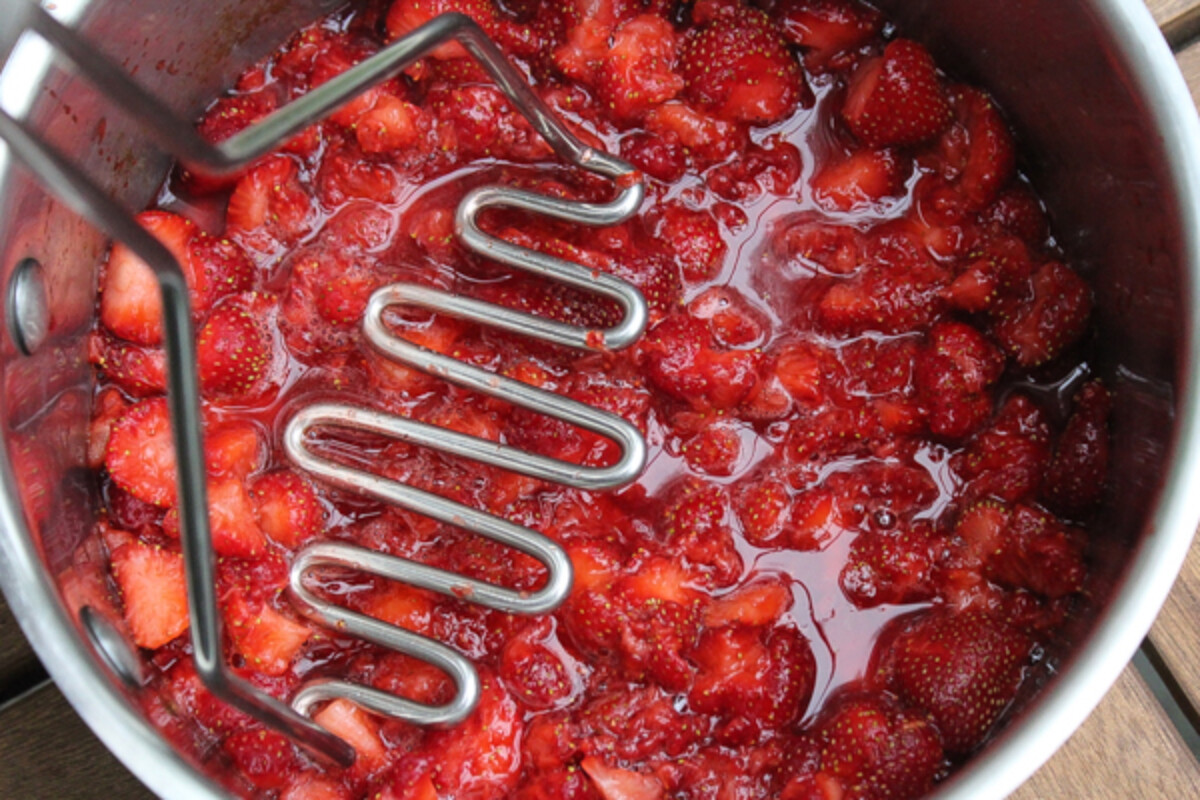
Once the strawberries are mashed up a bit and have released their juices, it’s time to get cooking. I’m using a low sugar pectin called Pomona’s Universal Pectin.
I’ve been canning with it for over a decade now and it’s never failed me. Some brands of pectin are activated by a high sugar content in the jam, and they simply won’t gel in low sugar recipes.
Pamona’s pectin is different. It can be used with both low sugar and no sugar recipes.
It uses natural calcium dissolved in water as the activator, and then the pectin itself is made from citrus peels. It’s completely flavorless and works flawlessly.
The trick is, you have to remember to add in both the calcium water and the pectin powder. I always add in the calcium water at the beginning along with the fruit so I don’t forget.
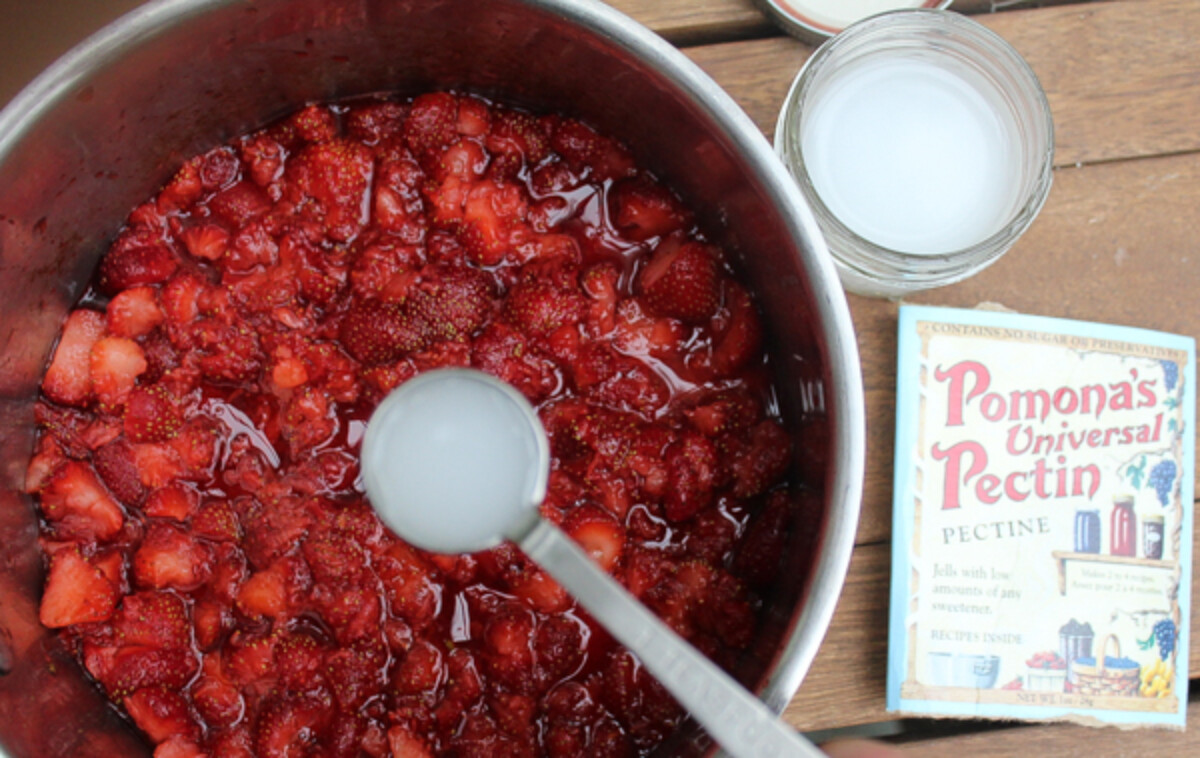
After the fruit is mashed and calcium water is added, it’s time to cook the fruit. At this point, there’s no sugar added, and you could choose to make a no sugar strawberry jam instead of a low sugar jam.
No sugar recipes may be healthier, but they taste a bit like food without salt. I’d rather add a very small amount of sugar, just enough to “salt” the jam and bring out the flavor of the fruit.
Either way, the berries need to simmer for about 10 minutes before the pectin and sugar are added. Be careful to keep the temperature low because boiling strawberry jam has a tendency to foam, and it will boil over if you’re not careful.
If it does start foaming, just give it a stir and it’ll settle down. Old school canners add in a pat of butter that helps keep it from foaming, and surprisingly it’s still just fine for canning.
I skip the butter though and just stir it. That keeps it from scorching on the bottom too.
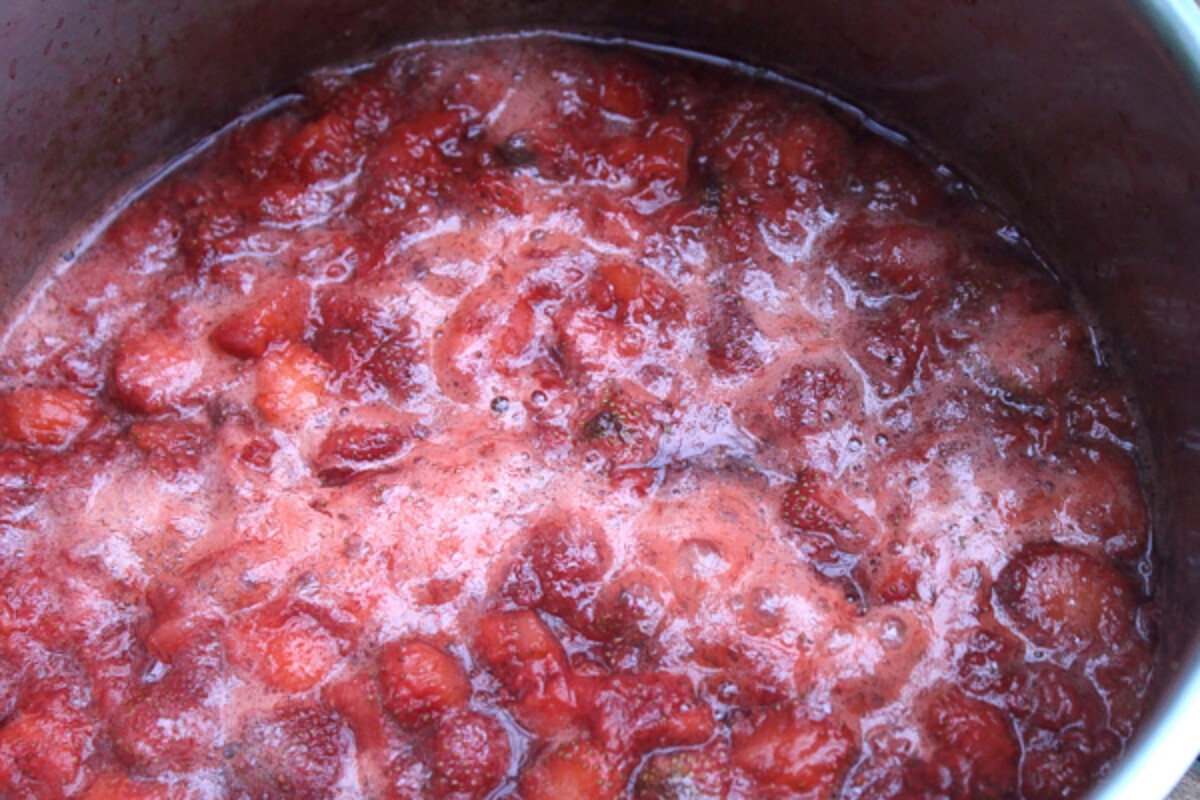
After the berries have been simmering for about 10 minutes, it’s time to add in the pectin and sugar. With Pomona’s pectin, the pectin is mixed right into the sweetener before it’s added into the fruit. This is important!
If you add the pectin directly into the jam, it will clump and you’ll be left with a lumpy mess rather than a thick, rich jam. That’s another reason why I always add at least 1/4 cup of sugar into any batch of jam.
That sugar is needed to distribute the pectin and prevent clumping. With at least 1/4 cup for every 2 teaspoons of pectin, I’ve never had clumping issues.
If you’re trying to make a no sugar recipe, you have no choice but to add the pectin right into the fruit. It will clump, but you get around it by blending the whole pot with an immersion blender for 2-3 minutes.
It’s completely pureed when you’re done, but the pectin is mixed in with no lumps. Since I like chunky jam, I stick to low sugar strawberry jam so I don’t have to puree it.
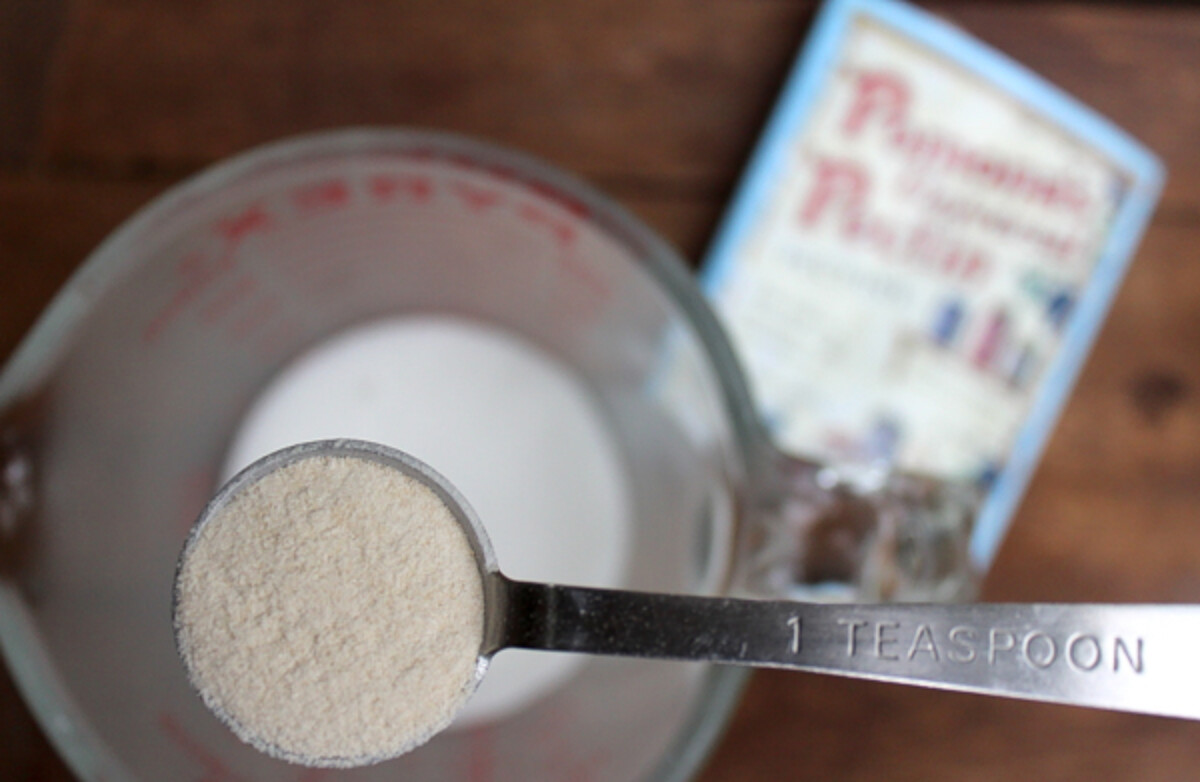
The next step is to mix the pectin and sugar mixture into the cooked fruit. Pour it in while stirring continuously to distribute it all evenly.
Let the jam simmer for another 1-2 minutes to fully dissolve the sugar and activate the pectin, but don’t overcook it. Continuing to cook the jam after you add the pectin will denature the pectin.
After 1-2 minutes, the strawberry jam will already be beginning to thicken. If you have a small batch going, and you trace a spatula across the bottom of the pan, it should part like the red sea and stay that way for a few seconds before the thick jam slowly fills back in.

After 1-2 minutes of cooking, remove the thickened jam from the heat, and ladle it into sterilized canning jars. At this point, you can choose to can the jam and make it shelf-stable, or you can just store it in the refrigerator.
The canning portion of this recipe is completely optional, and you can just add regular jar lids and store the jam in the refrigerator, no canning required.
It’s important to note though, that low sugar strawberry jam has a much shorter shelf life than high sugar jam. In the refrigerator, low sugar strawberry jam has at best 3 weeks before it spoils. If it’s canned, it lasts just as long as traditional strawberry jam on the shelf, but once opened that clock starts ticking.
I’ve had high sugar store-bought jam last for months, so that’s a big difference. There’s nothing like seeing all your hard work go down the drain when a homemade batch of low sugar jam spoils.
Be sure to use small canning jars, and use up any opened jars quickly. Three weeks is plenty of time if you’re using it even twice a week on toast or yogurt.
These days, I have two young children in the house, so if a jar makes it 3 days it’s a shock.
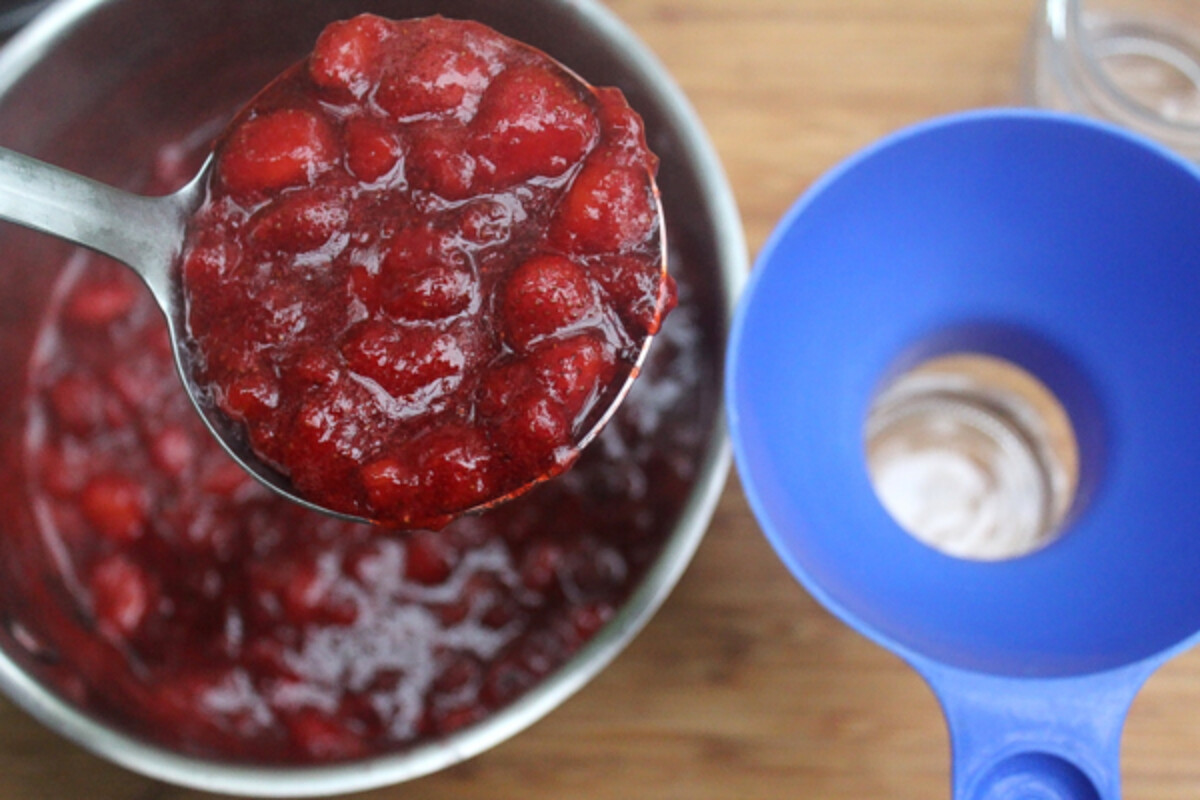
This recipe is for a small batch and yields 3 half-pint jam jars. Feel free to double the recipe, but I wouldn’t go beyond that for a single batch. When working with Pomona’s pectin it can be tricky to get all the jam into jars before it sets, and with a large batch, stirring can be a challenge.
Once the sugar and pectin are poured in, everything needs to be incorporated quickly and that just can’t happen in a huge stockpot. If you make a really large batch, you risk the strawberry jam not setting.
As always, the amount of sugar is up to you. Some recipes for strawberry jam include a cup of sugar for every cup of mashed fruit. In this recipe, I’m using 1/4 cup of sugar for every 4 cups of mashed fruit. That’s a huge difference, and the amount I’m using is the absolute minimum you need to distribute the pectin and prevent clumping.
I had very sweet and fresh homegrown strawberries, so use your best judgment based on your own berries. After you pour the sugar in, give it a stir and then taste it. You can always stir in a bit more sugar if necessary, just make sure you have it handy so you can add a bit more on the fly.
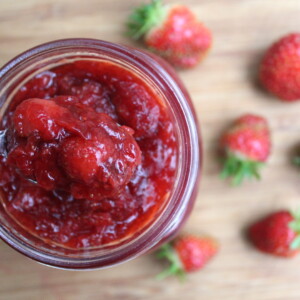
Low Sugar Strawberry Jam
Ingredients
- 4 cups strawberries, mashed
- 2 tsp calcium water, follow the instruction on Pomona package to prep
- 1/4 cup sugar
- 2 tsp Pomona's Pectin Powder
Instructions
- Wash and hull the strawberries. Mash them slightly with a potato masher and then measure the mashed berries.
- Place 4 cups of mashed berries in a saucepan with 2 teaspoons of calcium water. Bring to a simmer and cook for 10 minutes, stirring frequently.
- Measure the sugar and mix in 2 teaspoons of Pomona's pectin. Stir to distribute the pectin into the sugar before adding it into the strawberries.
- Add the pectin and sugar mixture into the simmering strawberries. Stir to distribute and continue to simmer for an additional 1-2 minutes.
- Use a ladle and funnel to pour the jam into prepared canning jars. Store in the refrigerator, or process in a water bath canner.
- If canning, use 1/4 inch of headspace and process half-pints for 10 minutes.
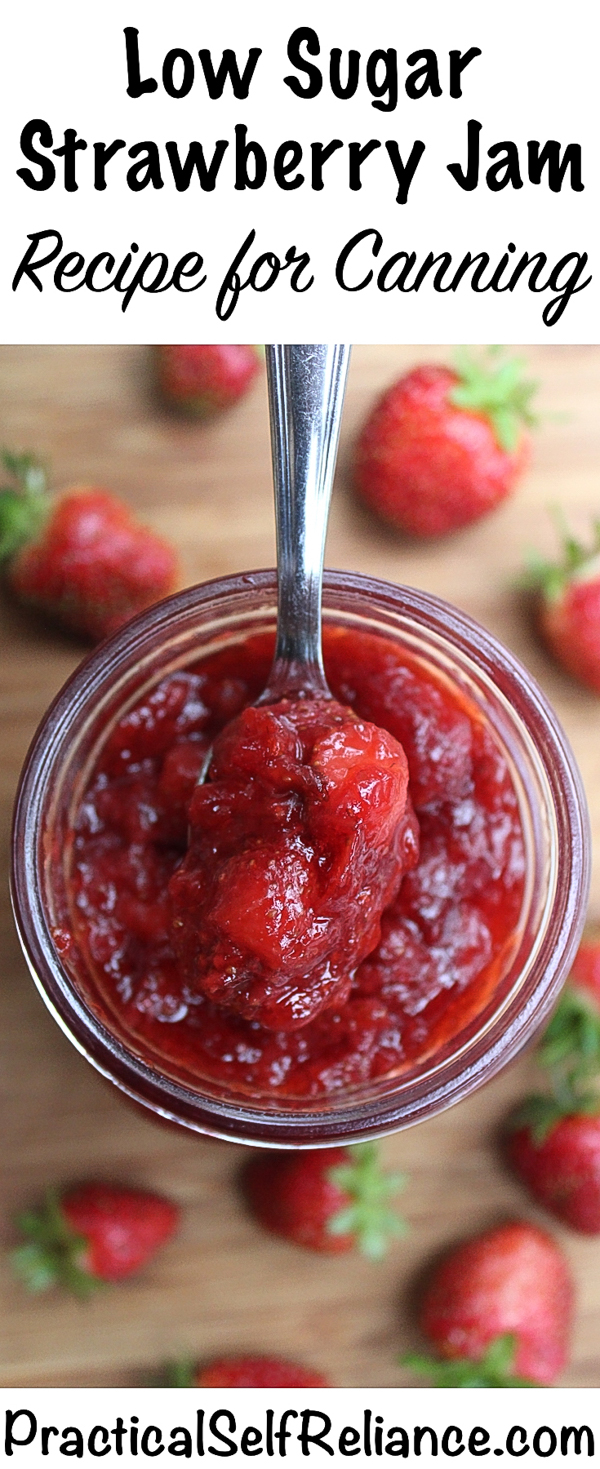

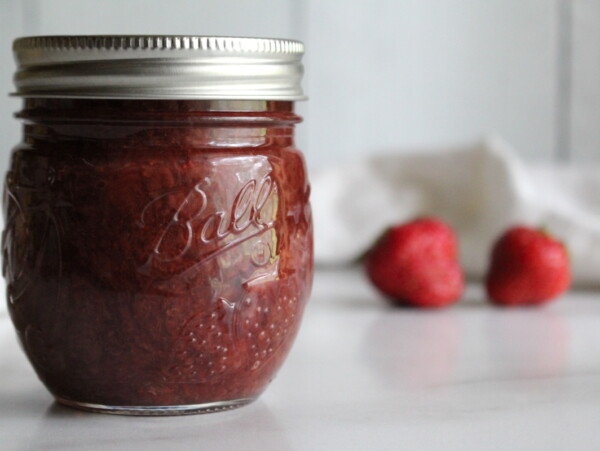












I want to use honey instead of sugar. Does the amount used change if it’s honey instead of sugar?
Thank you,
Ellen
Honey is sweeter than sugar, so you only need 2/3rds to 3/4 as much by volume for the same sweetness.
Thank you for this recipe…it turned out fantastic! I’m not a fan of a lot of sugar so when I came across this recipe I just had to try it. I made 6 half pints jars as I used 3 lbs. of strawberries and just increased the ingredients provided. Thanks again for this keeper!
Will this recipe work with another brand of low/no sugar pectin? Would the amount of pectin required be the same?
You can use any brand that you wish. I would follow the directions on the pectin to determine the amount needed and adjust it to fit the recipe.
I needed to hull quite a few strawberries & got tired of the paring knife. Inspiration was a heavy plastic straw from a reusable water bottle! I center on the bottom & push up through the berry, taking the whole stem out! A perfect hulled berry! I can’t wait to try this recipe!
Great tip! Thanks for sharing.
Can this low sugar strawberry jam be stored in the freezer for up to a year?
You sure can.
Can Stevia be used instead of sugar?
You can use Stevia that measures like sugar just like sugar in this recipe.
The title says it all! Thank you!
Your posts are so informative and easy to follow I have a question If I wanted to use pints instead of half pints in the Low Sugar Jam would I need to process more than 10 minutes in a water bath. I live near the strawberry fields in Plant City, Fl where you can pick them
The National Center for Food Preservation shows the same processing time for both pints and half pints.
You say you use 5 cups of mashed fruit and 1/4 cup of sugar but at the bottom in the recipe you list only 4 cups of fruit with 1/4 cup of sugar. Which amount of fruit is the correct amount to yield 3 jars?
Thank you for catching that type-o in the text. It should be 4 cups of mashed strawberries (measured after mashing) to yield 3 half pint jars of jam in this recipe. This can vary slightly, based on how much your strawberries cook down on the stove before you add the pectin.
Where do I get or how do I make calcium water? That is something I have not heard of before.
Pomona’s pectin comes with two parts. It has a calcium powder that you dissolve in water and keep in a jar in the fridge, and it has a pectin powder. Each box is enough for several batches of jam, so I just keep the pectin powder in a jar in the pantry and the calcium powder dissolved in water in a tiny jar in the fridge. Both last for years, so you can use them up in a few days if you’re a serious canner, or save them if it’s just an occasional thing.
Is this jam thick or slightly runny? I don’t care for thick gelatinous jam, I like it a bit runny, so I’m always scared to try a recipe that uses pectin. I’ve made jam in the past with just berries and sugar, and had excellent results, but that was with blackberries.
This one is good and thick, and will stand on a spoon. If you like runny jam, I’d suggest trying it with 1/4 the pectin. It’ll just barely come together then. You could also try pectin-free, but I’ve only done that with black currants which have a lot of natural pectin.